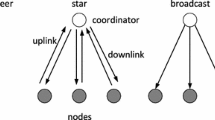Abstract
Provisioning of quality of service (QoS) is a key issue in wireless communication systems. Owing to the fact that QoS requirements are not very strict for all traffic types, more calls of higher priority traffic classes can be accommodated by blocking a slightly greater number of calls of lower priority traffic classes. Diverse types of high data rate traffic are supported by existing wireless communication systems, although resources are limited. Hence, priority-based resource allocation can ensure sufficient service quality for calls of important traffic classes. However, the use of fixed guard channels to prioritize any class of calls always reduces channel utilization. Hence, we propose a priority-based dynamic channel reservation scheme for higher priority calls that does not reduce channel utilization significantly. The number of reserved channels for each individual traffic class is calculated using real-time observation of call arrival rates for all traffic. The scheme reduces the call blocking probability for higher priority calls while simultaneously increasing channel utilization. The proposed channel reservation scheme can be efficiently applied for visible light communication (VLC) systems as well as for other wireless communication systems. The proposed Markov Chain model is expected to be very effective for queuing analysis and particularly for implementing a priority-based scheme for any number of traffic classes. We consider VLC as the system model for performance analysis. The numerical results show that the proposed scheme is able to attain a reasonable call blocking probability for higher priority calls, without sacrificing channel utilization.

Similar content being viewed by others
References
Sgora A., Vergados D.D.: Handoff prioritization and decision schemes in wireless cellular networks: a survey. IEEE Commun. Surv. Tutor. 11(4), 57–77 (2009)
Zhuang W., Bensaou B., Chua K.C.: Adaptive quality of service handoff priority scheme for mobile multimedia networks. IEEE Trans. Veh. Technol. 49(2), 494–505 (2000)
Cruz-Perez F.A., Ortigoza-Guerrero L.: Flexible resource allocation strategies for class-based QoS provisioning in mobile networks. IEEE Trans. Veh. Technol. 53(3), 805–819 (2004)
Vergados D.D.: Simulation and modeling bandwidth control in wireless healthcare information systems. Simulation 83(4), 347–364 (2007)
Habib I., Sherif M., Naghshineh M., Kermani P.: An adaptive quality of service channel borrowing algorithm for cellular networks. Int. J. Commun. Syst. 16(8), 759–777 (2003)
IEEE Standard for Local and Metropolitan Area Networks, Part 15.7: Short-Range Wireless Optical Communication Using Visible Light (2011)
Kim W.C., Bae C.S., Jeon S.Y., Pyun S.Y., Cho D.H.: Efficient resource allocation for rapid link recovery and visibility in visible light local area network. IEEE Trans. Consum. Electron. 56(2), 524–531 (2010)
Chowdhury M.Z., Jang Y.M., Haas Z.J.: Cost-effective frequency planning for capacity enhancement of femtocellular networks. Wirel. Pers. Commun. 60(1), 83–104 (2011)
Langer, K.-D.; Grubor, J.; Bouchet, O.; Tabach, M.E.; Walewski, J.W.; Randel, S.; Franke, M.; Nerreter, S.; O’Brien, D.C.; Faulkner, G.E.; Neokosmidis, I.; Ntogari, G.; Wolf, M.: Optical wireless communications for broadband access in home area networks. In: Proceedings of 10th Anniversary International Conference on International Conference on Transparent Optical Networks (ICTON), Athens, Greece, pp. 149–154 (2008)
Komine T., Haruyama S., Nakagawa M.: A study of shadowing on indoor visible-light wireless communication utilizing plural white led lighting. Wirel. Pers. Commun. 34(1–2), 211–225 (2005)
Chen H., Cheng C.-C, Yeh H.-H.: Guard-channel-based incremental and dynamic optimization on call admission control for next-generation QoS-aware heterogeneous systems. IEEE Trans. Veh. Technol. 57(5), 3064–3082 (2008)
Pandey V., Ghosal D., Mukherjee B., Wu X.: Call admission and handoff control in multi-tier cellular networks: algorithms and analysis. Wirel. Pers. Commun. 43(3), 857–878 (2007)
Senarath, G.N.; Everitt, D.: Performance of handover priority and queueing systems under different handover request strategies. In: Proceedings of IEEE 45th Vehicular Technology Conference, Chicago, USA, pp. 897–901 (1995)
Stojmenovic I.: Handbook of Wireless Networks and Mobile Computing. Wiley, New York (2002)
Soong T.T.: Probabilistic Modeling and Analysis in Science and Engineering. Wiley, New York (1981)
Author information
Authors and Affiliations
Corresponding author
Rights and permissions
About this article
Cite this article
Chowdhury, M.Z., Uddin, M.S. & Jang, Y.M. Dynamic Channel Allocation for Class-Based QoS Provisioning and Call Admission in Visible Light Communication. Arab J Sci Eng 39, 1007–1016 (2014). https://doi.org/10.1007/s13369-013-0680-4
Received:
Accepted:
Published:
Issue Date:
DOI: https://doi.org/10.1007/s13369-013-0680-4




